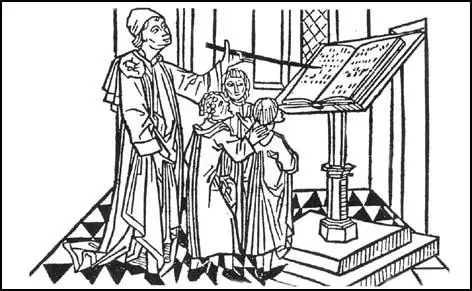Education in the Middle Ages
In 1330 only about 5% of the population could read or write. It was extremely rare for peasants to be literate. Some lords of the manor had laws banning serfs from being educated.
It was usually only the sons from rich families that went to school. There were three main types of schools in the 14th century: the elementary song-school, the monastic school and the grammar school.
The elementary song-school was usually attached to a large church in a town. At this type of school young boys were taught to sing Latin hymns and songs. If there was an educated priest available the boys might learn how to read and write.
Monastic schools were for boys being trained for the church. The boys were taught by monks and all lessons were concerned with religious education. Monastic schools sometimes taught local boys from poor families. In exchange for lessons these boys worked as servants in the monastery. For example, sometimes boys from Yalding were given permission to work at St. Mary Magdalene Priory in Tonbridge. This priory had been established by Richard de Clare in 1140.
Grammar schools were usually part of a cathedral or large church. The main concern of these schools was to teach boys Latin grammar. Grammar schools were very similar to the schools established by the Romans. As well as grammar the boys were taught logic (the art of arguing) and rhetoric (the art of public speaking). They also followed the Roman example of not spending much time on subjects such as mathematics and science.
Oxford and Cambridge were the two main centres of learning in England. Founded in the 12th century, these two universities took boys as soon as they were considered to be ready for advanced studies. This meant that some of the boys were as young as thirteen.

Students at Oxford and Cambridge obtained a Bachelor of Arts degree by attending an agreed number of lectures. If they wanted a Master of Arts degree they had to stay for another three years. As well as studying, these students had to become teachers at the university.
Elizabeth de Clare, who inherited a third of the family estates after the death of her brother at Bannockburn, took a keen interest in education. After the death of her third husband in 1322, Elizabeth decided against marrying again.
Elizabeth was one of the richest women in England. However, unlike a lot of rich people, Elizabeth believed it was important to help the poor. Her accounts show that in one five-month period she gave help to over 5,000 different people. Of these, 800 received a daily allowance from Elizabeth.
Elizabeth de Clare disagreed with the view that serfs should not go to school. She arranged for a large number of people who lived in her villages to be educated. She also paid for those boys who showed talent to be educated at Oxford and Cambridge universities.
In 1336 Elizabeth supplied the money for the foundation of Clare College, Cambridge. This provided an education for twenty scholars. As well as donating a considerable amount of money she also became involved in deciding what the students should study. Students at Clare College attended lectures on law, medicine, religion and the arts.
(1) Law passed by King Richard II and his Parliament in 1391.
No serf or villein.... should put his children to school.
1. Write a few sentences about the following types of school in the 14th century: (a) elementary song-school, (b) monastic school, (c) grammar school.
2. Describe what Elizabeth de Clare did to improve the education of the peasants who lived in the villages that she owned.
3. Read law 30 of the village Custumal and source B. Give as many reasons as you can why some people did not want the serfs to learn how to read and write.
4. Write a debate between Elizabeth de Clare and Ralph, Earl of Stafford, on the advantages and disadvantages of educating serfs.
